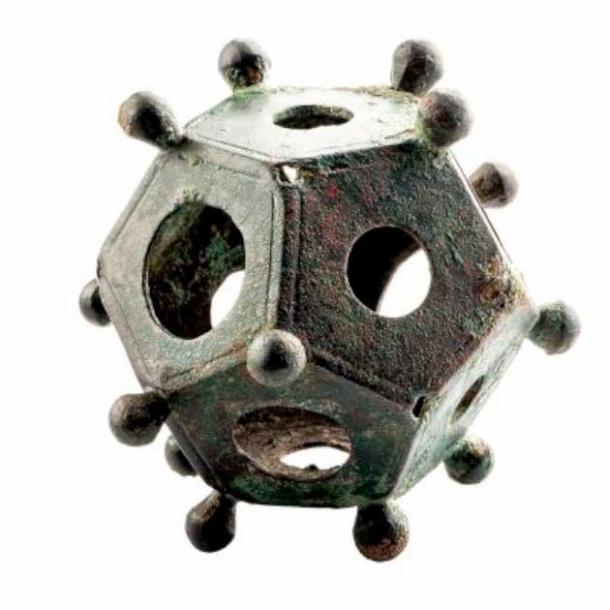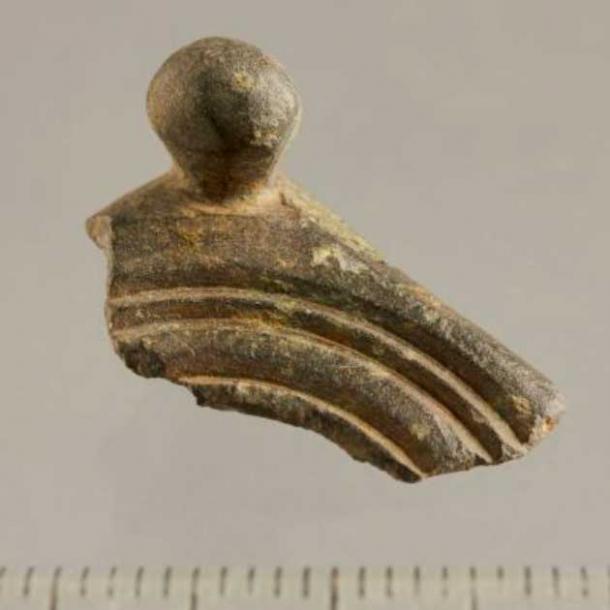
Mysterious Artifact Found in Belgium is Baffling Roman Dodecahedron Fragment
An amateur Belgian archaeologist was metal detecting in the Kortessem region when he unearthed a rare piece of a mysterious Roman geometric device known as a dodecahedron.
What is a Roman Dodecahedron? What was it Used for?
Dodecahedra are geometric bronze figures that were crafted during the Roman period using the lost-wax technique. Consisting of twelve pentagonal faces with circular openings, and typically with balls at the corners, the original purpose of these objects remains a mystery. While many historians believe they were important devices in Roman magic or religion, others maintain they were practical tools.
The primary function of the dodecahedra has never been determined but many theories and speculations exist. An Ancient Origins article explains that dodecahedra have been interpreted as “geometric sculptures, candlestick holders, dice, surveying instruments for range measuring objects on the battlefield, for estimating optimal sowing dates for winter grain, gauges to calibrate water pipes or standard army bases, staff or scepter decorations, a toy to throw and catch on a stick.”

An example of a complete Roman dodecahedron. (Flanders Heritage Agency)
A Rare Find in Flanders
On January 10, 2023, Patrick Schuermans, an experienced amateur archaeologist, was metal detecting in the Kortessem municipality of the Limburg province in Belgium. He stopped scanning when his metal detector screamed, and unearthed a bronze fragment of Roman dodecahedron. Schuermans reported his find to the Onroerend Erfgoed agency and a full investigation of the site, and the find, was conducted. It was later confirmed that the object was indeed a rare fragment from a Roman dodecahedron.
- The Enigma of the Roman Dodecahedra
- A Shining Example of Roman Craftsmanship: Unveiling the Superb Berthouville Treasure
Roman dodecahedra date from the 2nd or 3rd centuries AD and differ in detail, appearance, size, and weight. However, most measure between 4 centimeters to 11 centimeters (1.57-4.33 inches) in size. While about 120 specimens have been found across Great Britain, Belgium, Germany, France, Luxembourg, the Netherlands, Austria, Switzerland, and Hungary, only two dodecahedra have ever been found in Belgium.
Was it Ritually Broken?
The dodecahedron fragment discovered by Schuermans measures between 5 to 6 centimeters (1.96 -2.36 in) and is estimated to be around 1,600 years old. While examining the artifact, the team of Onroerend Erfgoed archaeologists identified an area that had been repaired. Furthermore, an article on Archaeonews explains that based on the fracture surfaces it is most likely that the dodecahedron was “broken during a ritual, as early as the Roman period.”

The fragment found in Flanders is clearly part of a Roman dodecahedron. (Kris Vandevorst/Flanders Heritage Agency)
It is interesting to consider that dodecahedra are never found in the area around the Mediterranean Sea, or to the south of it. They are almost always excavated in Celtic territories in the northwestern part of the Roman Empire, in present-day Belgium, the Netherlands, Germany, France, and Great Britain. For this reason, they are often cited as “Gallo-Roman dodecahedrons.”
Reconstructing and Testing Gallo-Roman Dodecahedra
Schuermans donated his find to the Gallo-Roman Museum of Tongeren, in the hopes that it will be exhibited beside the dodecahedron that is already in its collection, which was found around 1939 just outside the Roman city wall of Tongeren. In 1995 this museum created an exhibition about the Neanderthals in Europe, and in 2016 it won the Romulus Prize “for the massive efforts the museum provides to map Rome, Romans and ancient times in our country.”
- Looking for Answers: Unknown North American Artifact Unearthed in Pennsylvania
- Research Decodes Ancient Celtic Astronomy Symbols and Links them to Jungian Archetypes
While not one of the current explanations accounts for all of the objects' parts, experimental archaeologist Martin Hallett has a theory based on why dodecahedra are “only ever” found in colder climates. A YouTube video shows the researcher’s 3D printed replica of a Roman dodecahedron, and his suggested method for making hand warmers/gloves. In this idea, the holes in dodecahedrons are used to form glove’s fingers, and this might go some way to explaining why dodecahedra are different sizes as well - for making different sizes of gloves.
Top Image: The fragment of the mysterious Roman dodecahedron. (Flanders Heritage Agency) Insert: Dodecahedron from the region of Stuttgart; 2nd to 3rd Century. (Anagoria/ CC BY 3.0 )
By Ashley Cowie
















Comments
Daniel K Blackwood - YouTube
I would like to put forward a new description of the workings of the artifact, please.
The key to the Roman Dodecahedron is perspective.
In 2019 I came to the conclusion that the artifact can be photographed from any direction and would produce a unique silhouette from each and every angle it was photographed.
I found this to be true for the shadow cast by the artifact also.
This 3D form made up of 2D images resembles an unseen radiant star pointing in any and all directions. As a big bang projecting outward or a globe projecting inward.
Its uses could include a space compass used to navigate, map, or plot in 3D space.
Further, the true form I was seeking when I made this discovery was a 3D writing system and to be honest that is also plausible.
I understand that is a lot to fathom but for now I'm calling it perspective theory by Daniel K Blackwood.
Thank you.
It is certainly a good fit with the geographical distribution, but not so good as a finished product. Therefore, I remain sceptical, yet applaud the effort to understand the unknown.
I'd already formed the opinion that they were tools involved in the making of cords or thread before reading this article. Glove fingers is a similar concept I guess. I think the answer to these mysterious artifacts is out there in plain site, and the mechanics just need to be nutted out
I’m convinced these items are game pieces. They appear to have no practical purpose. We may never know their true purpose, but it’s fun to speculate.